Is a Chatbot Right for Your Business? Exploring Benefits, Use Cases and ROI.
In today’s fast-paced business environment, chatbots have gained significant attention for their potential to enhance customer experiences, save costs, and drive sales. This article aims to help you assess if a chatbot is the right fit for your business. By providing quick responses and personalised interactions, chatbots can create unique customer experiences. We’ll delve into the benefits, use cases, and ROI associated with implementing a chatbot.
I’m sure you’ve heard the chatter around chatbots over the last few years, and worldwide interest shows no sign of slowing down especially with the rise of AI in the last year. Google Trends shows an upward trend in search volume, and you can see clear evidence of this in the graph below.
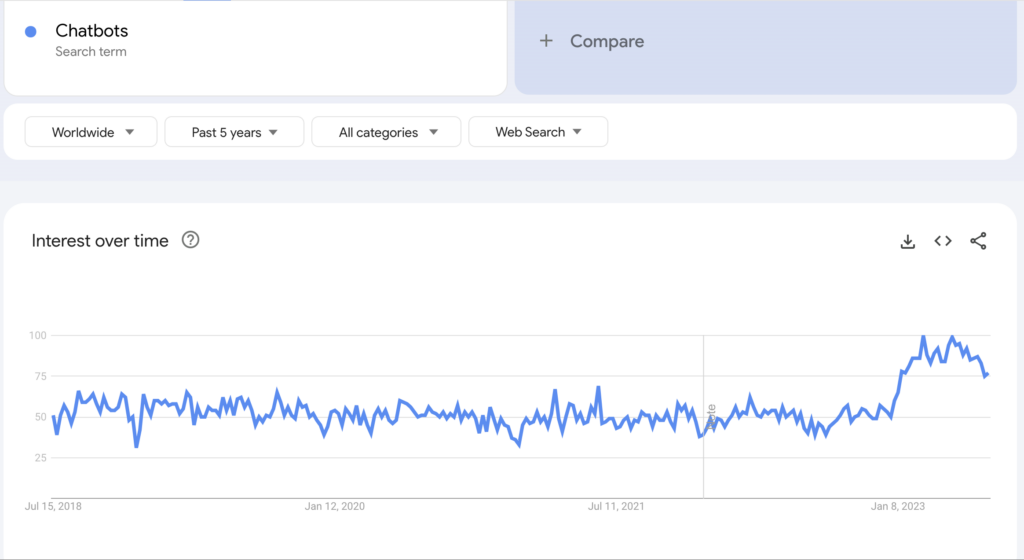
Source: Google Trends
We know that business leaders can see implementing a chatbot as an arduous task from some of the conversations we’ve had with our clients. I’ve collected the most common of our client’s questions and build out an introductory resource for them and others that cover the following:
- What is a Chatbot?
- What is a Chatbot used for?
- Why a Chatbot?
- What is the Return On Investment (ROI) for a Chatbot?
What is a Chatbot?
Chatbots are computer programs that automate specific tasks by engaging in conversation with customers through a conversational interface. They come in two main types: simple and smart. Simple chatbots work based on pre-written keywords and offer predefined response options, while smart chatbots utilise artificial intelligence to understand triggers, sentence structures, and provide contextually relevant answers.
You can see in the example from Kayak below that the chatbot asked me to choose from pre-programmed questions. The main benefit of this is that it’s easy, I didn’t have to think too hard, and as a bonus, it’s entertaining.
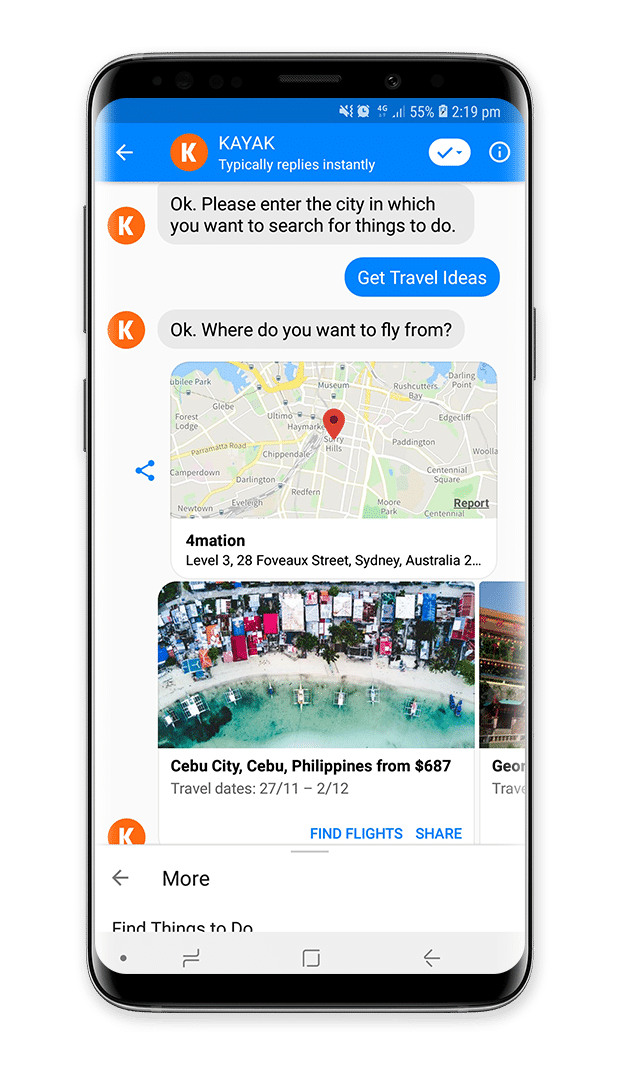
Source: Kayak
If you’re looking for something with more depth, then a smart chatbot could be what you’re after. These bots rely on artificial intelligence to communicate with users. Unlike the simple chatbots, smart chatbots should be able to understand trigger words and sentence structure. They’ll then provide an answer with relevance to the topic.
Smart chatbots that use more advanced forms of AI, Machine Learning and Natural Language Processing are helping to create human-like interactions which improve with every conversation. They also offer a higher level of customisation.
What is a Chatbot Used For?
With today’s technology chatbots can carry entire conversations. Chatbots now help businesses with their day to day operations and streamline many parts of a business including marketing, customer service and other processes.
Chatbots don’t only answer common questions or solve problems, but facilitate booking reservations, paying bills and purchasing items.
I’ve summarised the primary use case scenarios in four topics with examples below.
Customer service
How many times have you called a customer service number and received the prerecorded “your call is important to us, and we’ll be with you shortly” line, only to sit there waiting? I had an issue with my home internet last year and called my telco provider at least seven times. Countless hours later I was told to go to a specific web page which then solved my issue. All of this could have been resolved by a chatbot on the first point of contact.
A starting point is to look at what your most common customer service questions are. No matter what business you operate, your customers will have questions they want answered, fast. For a restaurant, this could be your weekly specials, opening hours, a link to your online menu, or booking a table. For an online computer parts store, the chatbot could check your stock levels and delivery times based on location. Keep it simple and helpful, and your customers will thank you.
Optus is one example of a company that is trying to streamline customer service. In the case below, the Optus bot greets me by name, introduces itself and tells me what it can do. It’s a lovely example of customer service in a chatbot.
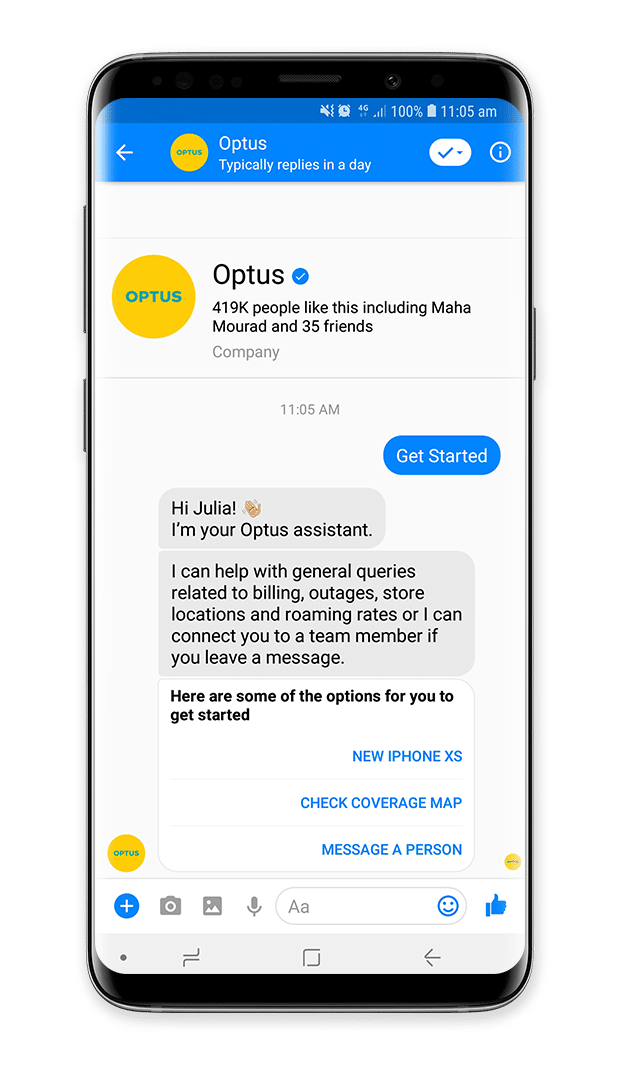
Source: Optus
Online shopping
A chatbot can also be a useful shopping assistant. Tell it your size, colour preference, occasion and sit back while the recommendations come rolling in. By treating your chatbot like a product search, your customers will get tailored results right from within their messenger app. Additionally, the chatbot will remember your customers’ individual preferences, so next time they come back, it can resume the shopping experience without asking for factors such as size again.
Chatbots also makes online shopping more convenient, even for something like buying tickets. You can see in this Ticketek example below that I typed “The Prodigy” and the bot came back with show information, as well as a link to buy tickets. It’s a convenient path to purchase.
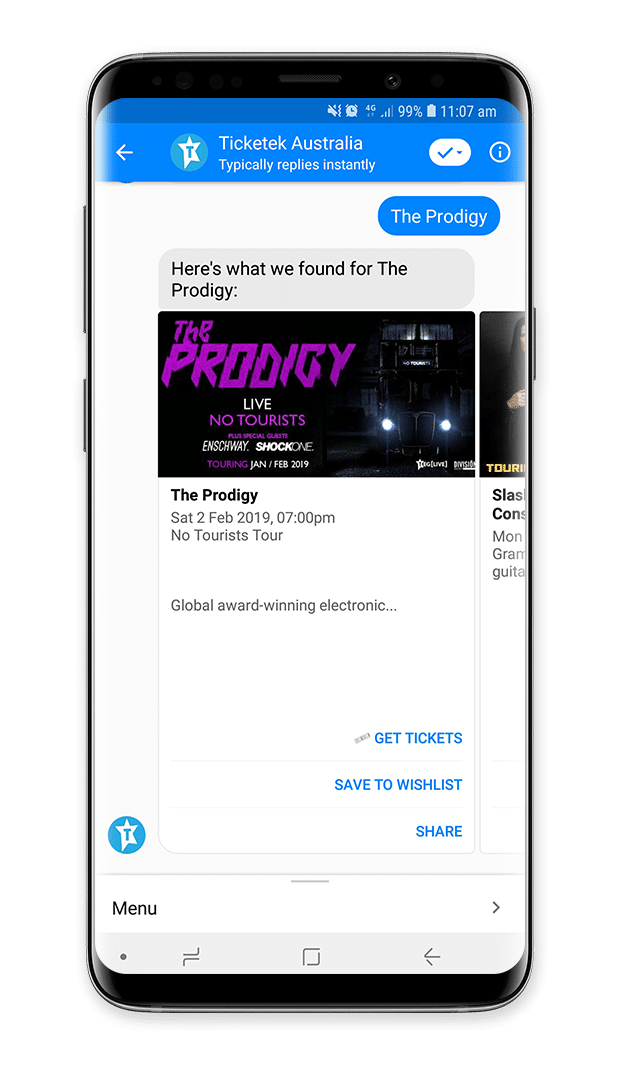
Source: Ticketek
Answer Common FAQs
Falling under customer service, but deserving of its own section, FAQs can be tricky. Creating an FAQ page can be helpful, however your customers may not want to go to your FAQ page and search for their question and corresponding answer. Chatbots solve this because they can answer immediately. For example, say I want to know how much shipping costs, I can ask the chatbot, “how much is shipping to Surry Hills?”. The chatbot can then come back to me with multiple answers based on speed and type. It could also link to a page with more information.
ZAFUL’s chatbot is the perfect example of this, they’ve suggested customers go to the FAQ page, or they can click one of the suggested FAQ topics.
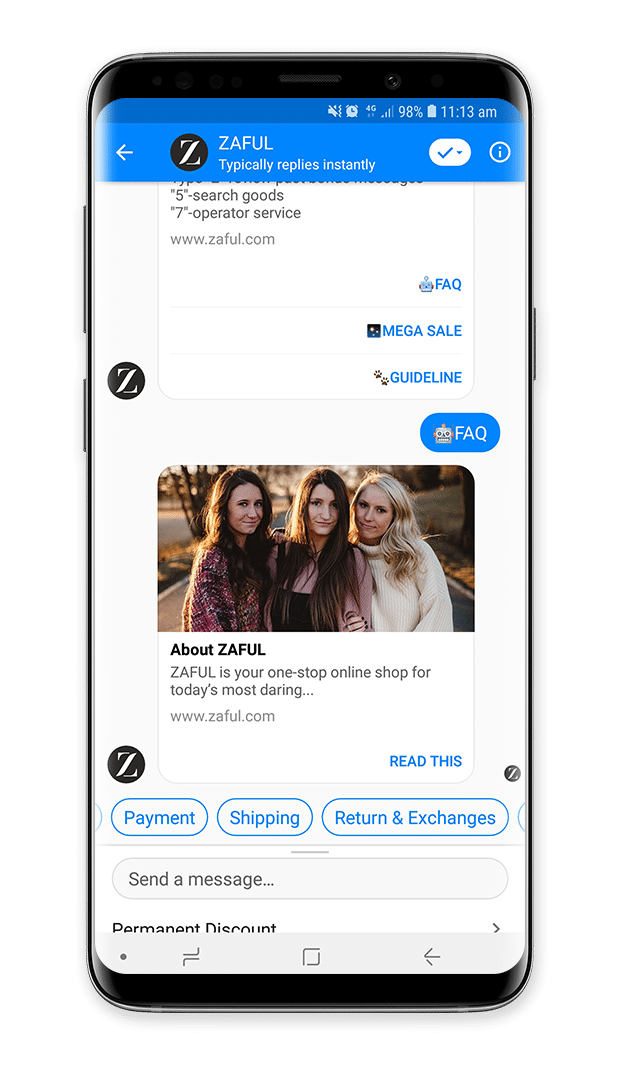
Source: Zaful
Personalisation
Chatbots can be an engaging and productive way to bring personalisation to a digital relationship with your customers. Besides the obvious, such as remembering your customer’s name and basic preferences, you can take your chatbot to the next level. If designed with intent, your chatbot has the potential to be a representative of your company. It can communicate your brand tone and values to customers. A good designer/copywriter is essential for this, don’t rely on just a piece of code.
Designers and copywriters can create personalised journeys for your customers through the chatbot experience. We all like feeling special, and you can achieve this by adding personal touches. Think about using humour, or referencing topics that may resonate with your target audience based on their interests or lifestyle.
Another quick win could be to ask their date of birth and send a promotional code on their birthday. When it comes down to it, what differentiates your chatbot from your competitor won’t be how it works, it’ll be how your customers feel after using it.
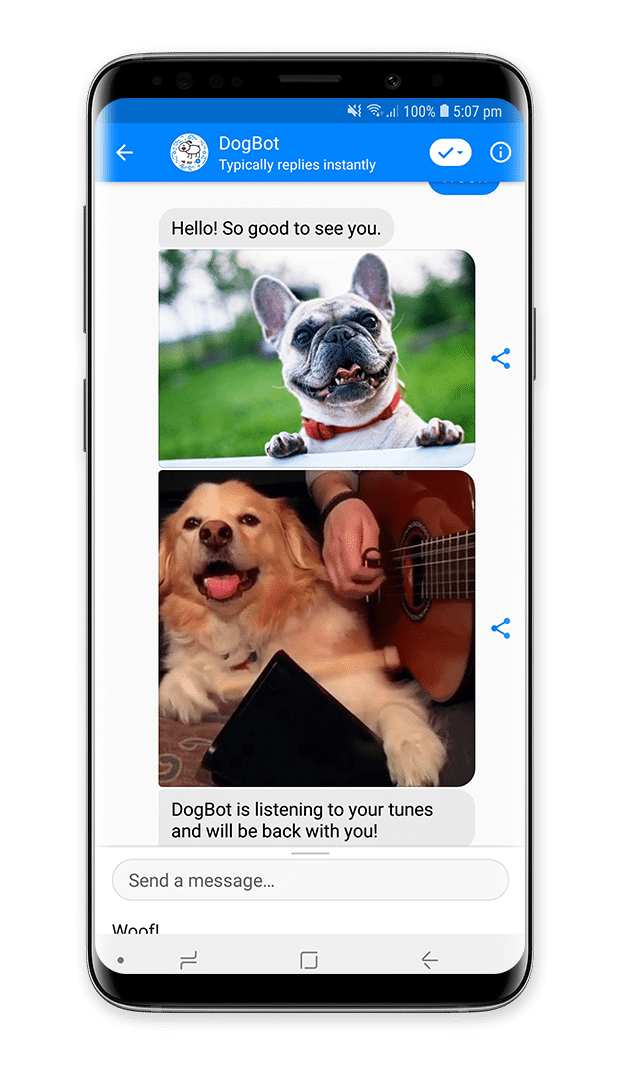
Source: DogBot by ManyChat
Why a Chatbot?
Why a chatbot and not a customer service representative or a sales assistant? According to IBM, businesses spend $1.3 trillion on 265 billion customer service calls each year. To put that in perspective, that’s 504,185 calls a minute. Chatbots could handle many of the caller’s questions and issues, instead of phone operators. Your customer service representatives will be freed up to deal with more complex problems.
Implementing a chatbot offers numerous benefits:
- Cost Savings: Chatbots reduce customer service costs by automating routine inquiries, freeing up resources to focus on more complex tasks. They handle a significant volume of customer interactions, saving expenses associated with hiring additional support staff.
- Enhanced Customer Satisfaction: Chatbots provide 24/7 availability, instant responses, and streamlined communication, leading to happier customers who appreciate quick and helpful assistance.
- Mobile-Friendly Experiences: Chatbots cater to the growing mobile shopping trend, offering personalized experiences that drive mobile sales and improve the mobile customer journey.
- Increase conversion rates: Chatbots can answer customer queries quickly meaning you can reduce buyers resistance. By a customer being able to have a question about a product or service with one click it enables them to make a purchasing decision quicker rather than going to another site.
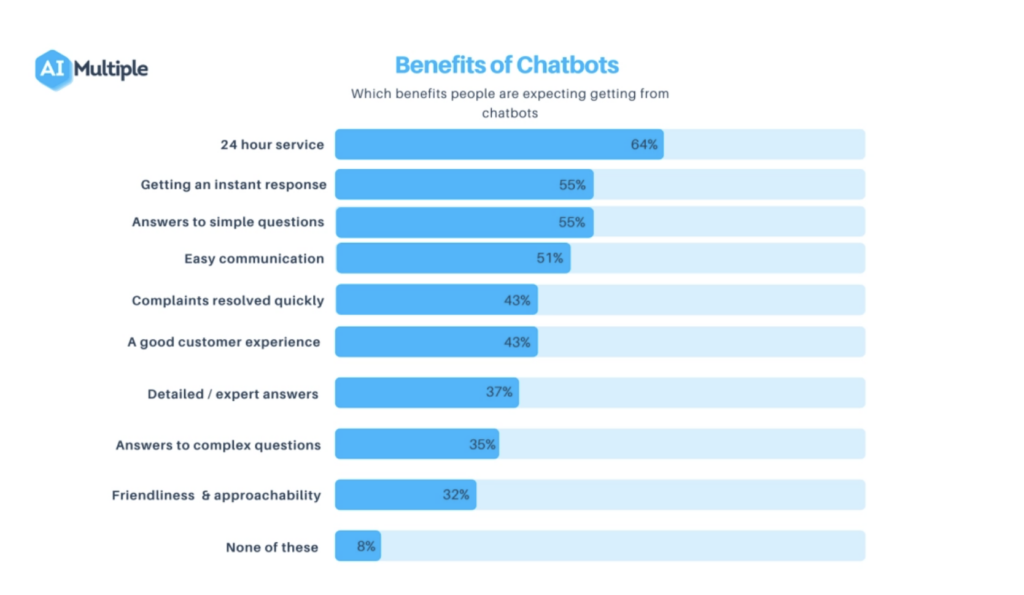
Source: AI multiple 2023
What is the Return On Investment (ROI) For a Chatbot?
You could calculate the ROI for a chatbot in multiple ways, and the ROI will be different for every business, based on the goals that are set.
Reducing expenses
If reducing expenses is one of your business goals, a chatbot can help. In Australia, one full-time customer service representative can cost a business $50,000 in yearly salary expenses, compared to a chatbot that is on average $2,400 annually.
Let’s break this down, you implement a platform chatbot across your website and Facebook Messenger at the cost of ~$2,400 for the year. You decide not to hire the extra customer service representative you planned to, saving you $50,000 for the year. That’s an expected ROI of $47,600.
50,000
– 2,400
———
ROI $47,600
Increasing sales
Chatbots also provide ROI by driving sales. From some of the money you’ve saved by not hiring an extra customer service representative, you could instead invest in creating awareness for you chatbot.
For example, you could create a series of ads targeting your existing customer base, introducing them to the chatbot and its capabilities. As a result of this activity, you’ve increased sales volume in channels that can be directly attributed to the chatbot.
As a real-world example, we can see that when a chatbot is used strategically it can drive great results for businesses. According to ManyChat, one of their customers, DigitalMarketer, saw an ROI of 500%. DigitalMarketer used Facebook Newsfeed ads to drive traffic to Messenger and then converted that into sales through conversational selling with their chatbot. It makes sense to use a chatbot to sell, with Messenger open rates sitting around 80-90%, with a 20%+ CTR. Compare this with email open rates around 21% and you can see why Messenger wins out.
With a little creativity, and cunning, you can also make a chatbot for your business that drives sales and cuts your customer service costs.
The Wrap Up
Is a chatbot right for your business? Well, it depends.
Do you find yourself, or your customer service team spending time answering common questions or fulfilling essential help functions?
Do you want to drive your mobile sales in both volume and ATV?
Do you want to improve your customer journey and provide a memorable experience?
Do you want to build a competitive advantage?
If you found yourself nodding along, then yes, a chatbot may be right for your business.
We have experience in implementing AI chatbots for our clients and are ready to help you skyrocket your sales, reduce your expenses and get ahead of your competition. Contact us today!

